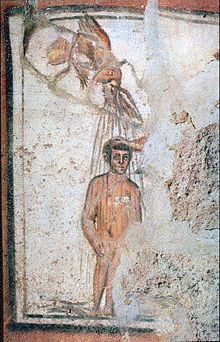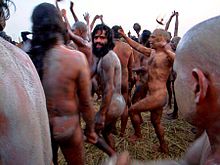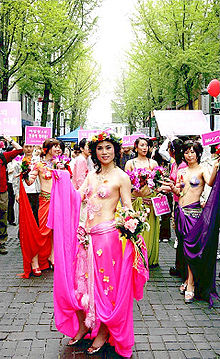- Nudity in religion
-
Attitudes to nudity differ among world religions.
Contents
Abrahamic religions
The Abrahamic religions of Judaism, Christianity, and Islam all recount the legend of Adam and Eve in the Garden of Eden found in the Hebrew Bible, who are not aware that they are naked until they eat the fruit of the Tree of Knowledge of Good and Evil. When they discover their nudity, they are ashamed and cover themselves with fig leaves.[1][2] Each of these religions have their own unique understanding of what is meant to be taught with the recounting of the story of Adam and Eve and the use of nudity in the Hebrew Bible. In Christianity, nudity is associated with original sin, an integral aspect to their doctrine of redemption and salvation. In Islam, it is to show that women and men should be covered in clothing, for nudity has the stigma of shame attached it.[3] In Judaism, nudity in and of itself is not sinful, being that it is a natural part of God's divine creation. And, many of the references to nudity or "nakedness" in the Hebrew Bible is understood as a polite euphemism for intimate behavior.[4] For example, in the legend of Noah we experience the hesitancy of two of Noah's sons when they have to cover their father's nakedness, averting their eyes, after Noah's youngest son "saw his father's nakedness and told his two brothers outside" what he had done to his father.[5][6]
Judaism
In general, Judaism has a rather clothes-on attitude towards nudity in most social and familial situations, except when it is impractical to do so (for example, when taking a shower) or when it's necessary to be naked for ritual purposes (for example, while performing ritual tevilah in a mikveh[7]) or while engaged in sexual intimacy. Within Jewish cultural and religious tradition, the determination on how much one can appropriately show of one's body privately and publicly is made by a community's interpretation of Halakha, Jewish law. And, these interpretations vary noticeably between the different movements within Judaism. In the more strict (orthodox) communities, nudity is very carefully regulated in an effort to limit viewing by others, to include even one's spouse. In more liberal Jewish communities, viewing the body in its nude state is not socially condoned, but is left more up to the view, beliefs, and personal lifestyles of the individual. The Jewish requirement that one be clothed for Tzniut (sake of modesty) "is not a result of any of the prohibitions in the Torah. Rather, it is ... dependent upon what it is that makes one ashamed when standing before people."[8] With the exception of the Haredi community, Jewish communities generally tend to dress and, likewise, undress according to the standards of the society that is around them.
Full nudity is permitted, and according to many, encouraged, during sexual intercourse. There are opinions that it must be done in the dark, at night, and in private, but most of these issues revolve around partners' respective feelings of embarrassment or insecurity, and possible concern that partners may sometimes not fairly judge their partners' respective physical attractiveness. Practices currently vary among Orthodox Jews.
Conservative and Reform Judaism generally do not follow the Jewish law. Attitudes toward modesty and sexual intercourse vary widely, though both movements emphasize strong partnerships and intimacy while discouraging promiscuity,[9] as the Orthodox.
- See also Tzniut for the Jewish rules on modesty, especially regarding female clothing.
Christianity
The early Christian Church reflected contemporary attitudes towards nudity, where it was considered acceptable in some contexts such as working outdoors. For example Gospel of John 21:7 describes that Simon Peter is naked while fishing from a boat, but then gets dressed in order to meet Christ.
The first recorded liturgy of baptism, written down by Saint Hippolytus of Rome in his 'Apostolic Tradition', required men, women and children to remove all clothing, including all foreign objects such as jewellery and hair fastenings.[10] This practice is reflected in early Christian art depicting baptism.
Later Christian attitudes to nudity became more restricted, and baptisms were segregated by sex and then later were usually performed with clothed participants. Some of the Eastern Orthodox churches today maintain the early church's liturgical use of baptismal nudity, particularly for infants but also for adults.
One may also note the comments of Pope John Paul II in this matter: "The human body can remain nude and uncovered and preserve intact its splendour and its beauty... Nakedness as such is not to be equated with physical shamelessness... Immodesty is present only when nakedness plays a negative role with regard to the value of the person...The human body is not in itself shameful... Shamelessness (just like shame and modesty) is a function of the interior of a person."[11]
Christian tradition does not usually teach that nudity is inherently wrong, but many Christians believe that it is only acceptable between marriage partners, and between children, or children and their parents.[citation needed]
Early Christian art included depictions of nudity in baptism. When artistic endeavours revived following the Renaissance, the Catholic Church was a major sponsor of art bearing a religious theme, many of which included subjects in various states of dress and including full nudity. Painters sponsored by the Church included Caravaggio and Michelangelo, but there were many other. Many of these paintings and statues were and continue to be displayed in churches, some of which were painted as murals, the most famous of which are at the Sistine Chapel painted by Michelangelo.
Movements within Christianity have arisen from time to time that have viewed nudity in a more positive light. For example, to the Adamites and the Doukhobor sect social nudity was an integral part of their practices. Today, Christian naturists maintain that social nudity is a normal part of Christianity and acceptable.[12] A common thread that runs through these groups is the belief the human body is God's greatest creation, and that Christ's death replaced the blood sacrifice in making animal skins after Adam and Eve disobeyed God in the Garden of Eden. Furthermore, it had been Adam and Eve's own decision to cover up what they had done by using fig leaves, which proved to be inadequate.[citation needed]
Islam
In Islam the area of the body not meant to be exposed in public is called the awrah, and while referred to in the Qur'an, is addressed in more detail in hadith.[13]
- For men, the awrah is from the navel to knees, which means that Muslim men have to cover themselves at least from the navel down to the knees in front of other men or women. However, in most Islamic cultures (if not all), a man is frowned upon should he walk around in public without covering the upper half of his body.
- For women, the awrah is from chest to knees in front of other women. In front of men, it is the whole body, apart from the hands and the face. Salafi Muslims who wear the niqab, believe that a woman’s awrah in front of unrelated men is her entire body including her face and hands[14] A woman's clothing is required to be loose and opaque, and she is encouraged to wear trousers under her loose garment.
South Asian religions
In ancient South Asian cultures, there was a tradition of extreme ascetism (obviously minoritarian) that included full nudity. This tradition continued from the gymnosophists (philosophers in Antiquity) to certain holy men (who may however cover themselves with ashes) in present day Hindu devotion and in Jainism.
Hinduism
Among the Hindu deities, only the Goddess Mahakali and/or Kali is depicted as sky-clad, wearing the limbs around her waist and human skulls as garland in her neck.
Among the Hindu religious sect only sect known as Naga sadhu can be seen nude. These Sadhus usually remain sky-clad or some wear a loin-cloth around their waist. They usually remain in their Akhara or deep forest or isolation and come out in public only once every four years during Kumbh Mela. They have very long history and are warrior monks, who usually also Talwar, Trishul, Bhala or such weapons and in medieval times have fought many wars to protect Hindu Temples & shrines.
Similarly Aghori, followers of mystic Tantric rituals, usually done in isolated places or cremation grounds can be found nude. But, neither they come in public usually nor do generally public go to meet them. Sightings of Aghori in public palace is very rare.
Jainism
In Jain religion there is major sect of Digambar Jain, whose monks remain nude.
New religious movements
Wicca
In many modern NeoPagan religions, such as Wicca, social and ritual nudity are (relatively) commonplace. In Wicca, the term skyclad is used to denote ritual nudity as opposed to social nudity.
Raelism
In Raelism, there is nothing problematic with nudity.
References
- ^ Genesis 3:7 "And the eyes of them both were opened, and they knew that they [were] naked; and they sewed fig leaves together, and made themselves aprons"
- ^ Koran7:20 "when they tasted of the tree, their shame became manifest to them, and they began to sew together the leaves of the garden over their bodies."
- ^ Koran7:26 "O children of Adam! We have indeed sent down to you clothing to cover your shame, and (clothing) for beauty and clothing that guards (against evil), that is the best."
- ^ "as a euphemism for sexual relations," pg 17-18, Biblical Literacy, Rabbi Joseph Telushkin, William Morrow and Company, New York, 1977
- ^ Genesis 9:21-25 "[Noah] drank the wine [of his vineyard] and became drunk. He uncovered himself inside his tent. Ham saw his father's nakedness and told his two brothers outside. And Shem and Japheth took a garment, and laid [it] upon both their backs, and went backward, and covered the nakedness of their father; and their faces [were] backward, and they saw not their father's nakedness. And when Noah awoke and learned what [Ham] had done to him, he said "Cursed be Canaan [Ham's son], the lowest of slaves shall he be to his brothers"
- ^ Note: it has been suggested (D. L. Edwards (1989) A Key to the Old Testament, Fount Paperbacks ISBN 0 00 6251927, page 113) that this episode involved Ham doing more than just viewing his father's nakedness
- ^ Mishnah, Mikvaos 9:3; Shulchan Aruch, Yoreh Deah 198:1
- ^ Ig’ro’t Moshe, Yorah Dey’ah, Vol. 3, No. 68:4
- ^ http://urj.org//about/union/leadership/yoffie//?syspage=article&item_id=6076
- ^ The Apostolic Tradition of Hippolytus of Rome - chapter 21:1-5:
- 1 At the hour in which the cock crows, they shall first pray over the water.
- 2 When they come to the water, the water shall be pure and flowing, that is, the water of a spring or a flowing body of water.
- 3 Then they shall take off all their clothes.
- 4 The children shall be baptized first. All of the children who can answer for themselves, let them answer. If there are any children who cannot answer for themselves, let their parents answer for them, or someone else from their family.
- 5 After this, the men will be baptized. Finally, the women, after they have unbound their hair, and removed their jewelry. No one shall take any foreign object with themselves down into the water.
- ^ Karol Cardinal Woytyla (John Paul II), Love and Responsibility, translation by H. T. Willetts, Farrar, Straus and Giroux, New York: 1981.
- ^ Christian Nudist Convocation : Supporting and Gathering Christian Nudists
- ^ Bukhari:6:60:282}, Sunnan Abu Dawud 32:4091
- ^ Mohammad Nasir (March 23, 2007). "In Defense of The Obligation of Niqab". Seeking Ilm. http://seekingilm.com/archives/44. Retrieved 2008-06-02.
See also
- Christian naturism
- Social nudity
- History of nudity
Categories:- Nudity
- Religious behaviour and experience
Wikimedia Foundation. 2010.



